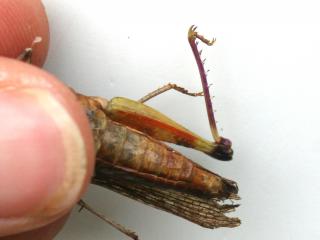Grasshoppers are hatching
- Coorow
Recently there have been isolated reports of sand grasshoppers hatching in the Coorow area.
Last year the sand grasshopper caused feeding damage to crops and pastures at Coorow and on sandy soils across the West Midlands. This feeding damage combined with other contributing factors, such as a false break, over-grazing, or a low pasture seed bank, resulted in many pasture paddocks having low ground cover in 2021 despite the favourable seasonal conditions.
Widespread surveillance was conducted by DPIRD staff across the West Mildands area before the start of the 2022 growing season and this surveillance indicated that there were very low numbers of grasshoppers present.
Monitoring and management
Growers and consultants, particularly in the West Midlands region, are reminded to closely monitor paddocks for Common Urnisa grasshoppers, which are also known as sand grasshoppers.
Common Urnisa is usually mottled and is a reddish-brown colour or grey, depending on its habitat. The Common Urnisa lacks the 'x' on its thorax that can be seen on the APL. The hind legs of the Common Urnisa has two dark bands across it and is yellow to orange on the inside whereas the lower part of the leg (tibia) is a purple to red colour and the knees are almost black.

If crop or pasture loss is occurring due to grasshopper activity insecticides can be applied to control hatching nymphs. Nymphs are easier to control than adult grasshoppers. Insecticides registered for APL control will have efficacy on this grasshopper.
For more insecticide information refer to DPIRD’s Australian plague locust control: registered insecticides page and search for registered insecticides on the Australian Pesticides and Vetinerary Medicines Authority website.
If pasture paddocks have no grasshoppers but low seedling numbers, this is likely a sign of a low pasture seed bank. Research scientist Geoff Moore (DPIRD) recommends supplementary over-sowing of a cereal-pasture mix. Producers need to be proactive and have a plan in place to prevent wind erosion and maximise pasture productivity for the 2022 growing season.
More information on seasonal issues, including land and water management, can be found on DPIRD’s Season 2022 webpages.
For more information on Urnisa grasshoppers refer to;
- DPIRD’s Identifying and controlling Urnisa grasshopper or sand grasshopper page
- DPIRD’s Australian plague locusts and grasshoppers podcast
- West Midland’s Group Getting the jump on grasshoppers and locusts with Svetlana Micic podcast.
For more information contact Research scientist Svetlana Micic, Albany on +61 (0)8 9892 8591.
Article authors: Svetlana Micic (DPIRD Albany).
